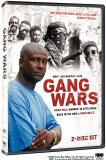| Reviews & Columns |
|
Reviews DVD TV on DVD Blu-ray 4K UHD International DVDs In Theaters Reviews by Studio Video Games Features Collector Series DVDs Easter Egg Database Interviews DVD Talk Radio Feature Articles Columns Anime Talk DVD Savant Horror DVDs The M.O.D. Squad Art House HD Talk Silent DVD
|
DVD Talk Forum |
|
|
| Resources |
|
DVD Price Search Customer Service #'s RCE Info Links |
|
Columns
|
|
|
Gang Wars
HBO // Unrated // September 5, 2006
List Price: $24.98 [Buy now and save at Amazon]
"There ain't no options, man. There ain't nothin' to do but gangbang and sell dope, man...drink beer and hang on the corner. That's all there is to do. That's all there is to do."Despite its comparatively meager population
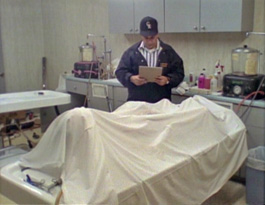 of 177,000 in 1993, the midwestern city of Little Rock, Arkansas had more murders per capita than the sprawling metropolises of New York and Los Angeles. Not only were an increasing number of bodies piling up in the morgue, but county coroner Steve Nawojczyk noticed another disturbing trend: the murder victims were getting younger and younger. Bangin' in Little Rock, perhaps the most memorable of HBO's many documentaries, follows Nawojczyk as he tries to educate the trigger-happy teenaged thugs on the inevitable conclusion to the gang lifestyle. Bangin' in Little Rock also delves into the minds of these kids, letting them explain in their own words (with then-oblique gang jargon like "stacking" defined by the producers) why they've settled into this lifestyle. Nawojczyk's determination to try to set these children on the right path...to stave off the bloodshed...is undeniably admirable, but it's hearing and seeing these kids act out their violent fantasies that makes this documentary so fascinating.
of 177,000 in 1993, the midwestern city of Little Rock, Arkansas had more murders per capita than the sprawling metropolises of New York and Los Angeles. Not only were an increasing number of bodies piling up in the morgue, but county coroner Steve Nawojczyk noticed another disturbing trend: the murder victims were getting younger and younger. Bangin' in Little Rock, perhaps the most memorable of HBO's many documentaries, follows Nawojczyk as he tries to educate the trigger-happy teenaged thugs on the inevitable conclusion to the gang lifestyle. Bangin' in Little Rock also delves into the minds of these kids, letting them explain in their own words (with then-oblique gang jargon like "stacking" defined by the producers) why they've settled into this lifestyle. Nawojczyk's determination to try to set these children on the right path...to stave off the bloodshed...is undeniably admirable, but it's hearing and seeing these kids act out their violent fantasies that makes this documentary so fascinating. The scores of gangs in Little Rock -- many of whom infiltrated the Midwest from much larger cities -- are racially diverse. It's not just the young black kids of stereotype. The filmmakers show a teenage girl being initiated into a gang by fighting (bloodily and unsuccessfully) against the other members, all part of a ploy to win their approval. Another girl, disillusioned with her family life and desperate for acceptance, lets herself be branded with a pitchfork on her back. The violence is so pervasive that gang members out of habit keep an eye open for passing cars on the way out the front door. Terrified of being caught in the crossfire, some innocent people resort to sleeping in their bathtubs thinking that this might keep them out of the line of fire. The filmmakers themselves are even caught in the middle of a drive-by shooting at one point. Thanks to the candid, shockingly honest responses from its many interviewees, Bangin' in Little Rock effectively conveys the fear, anger, longing, and arrogance of those involved. This is a documentary that has left an indelible impact on many who have seen it, and even though it's been twelve years since it first aired on HBO, I still come across nods to Bangin' in Little Rock fairly regularly.
"I don't blame Osama, y'know what I'm sayin'? If he came in my yard, I'd kill his ass, y'know what I'm sayin'? But long as he don't come on the four block, I ain't fucked up about what he do, y'know what I'm sayin'? 'Cuz...shit, it's a motherfucker, y'know what I'm sayin'? He's trying to hustle and survive, too, y'know what I'm sayin'? He's trying to look out for his people just like I'm trying to look out for the four block, y'know what I'm sayin'? Shit, if I had to blow a motherfucker, knock a motherfucker's ass out to make them realize Goddammit what the fuck I'm trying to get across, my point across...? Shit, then that's what I'll do."HBO Undercover's cameras returned a decade later for the follow-up piece Back in the Hood: Gang War 2. Bangin' in Little Rock had a clear message: if
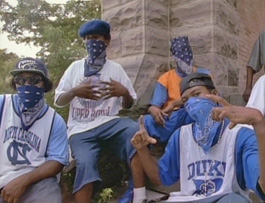 gang violence can overrun a middle American city like Little Rock, it can happen anywhere. Its sequel doesn't have as focused or compelling a message, sporadically likening the gangs in Little Rock to the turbulence in the post-9/11 Middle East but not offering a unique, impassioned point of view from any direction. The most instantly engaging aspect of Bangin' in Little Rock -- the reason it's still so frequently referenced twelve years later -- is the arrogant, ignorant children who kill each other without really understanding the consequences and who are convinced that these gangs they've joined at 14 or 15 are going to nurture them and be there for the rest of their lives. Back in the Hood is told entirely from an adult perspective, one that's certainly valid but is far more familiar. It's not about the internal strife between punk kids and the collateral damage they irresponsibly cause but more gangs versus societal ills...the long term consequences of this sort of life. Bangin' in Little Rock shows the gang life firsthand; the preachier Back in the Hood just talks about it.
gang violence can overrun a middle American city like Little Rock, it can happen anywhere. Its sequel doesn't have as focused or compelling a message, sporadically likening the gangs in Little Rock to the turbulence in the post-9/11 Middle East but not offering a unique, impassioned point of view from any direction. The most instantly engaging aspect of Bangin' in Little Rock -- the reason it's still so frequently referenced twelve years later -- is the arrogant, ignorant children who kill each other without really understanding the consequences and who are convinced that these gangs they've joined at 14 or 15 are going to nurture them and be there for the rest of their lives. Back in the Hood is told entirely from an adult perspective, one that's certainly valid but is far more familiar. It's not about the internal strife between punk kids and the collateral damage they irresponsibly cause but more gangs versus societal ills...the long term consequences of this sort of life. Bangin' in Little Rock shows the gang life firsthand; the preachier Back in the Hood just talks about it. Back in the Hood is told primarily from the perspective of Leifel Jackson, the OGC leader targeted in the drive-by documented in Bangin' in Little Rock. Ten years later, we catch up with Jackson -- doughier, graying, and still mistrusted by the police -- as he counsels kids, trying to steer them away from the thug lifestyle while struggling to feed his own infant daughter. I appreciate the tumult I'm sure he's suffering through in life, but he's just not that fascinating a subject. I would've liked to have seen less of Jackson and more of the personable Marvin, who boasts at one point that if he makes it as a rapper, he's going to level a block and build his mansion (gated and with heavy security, naturally) in the 'hood. Back in the Hood also lacks anything with the intensity and immediacy of the drive-by in Bangin' in Little Rock, instead splicing in footage of a guy gunned down after confronting the cops with an automatic rifle. This footage is more violent, certainly, but its inclusion seems like such a tacked-on afterthought that it doesn't carry nearly the same impact.
HBO presents both documentaries in an unnecessary two-disc set, presumably for marketing purposes as both films and all of the accompanying extras could easily fit on a single disc. Despite the inclusion of the follow-up documentary and a handful of extras, the only really noteworthy aspect of this Gang Wars DVD set is Bangin' in Little Rock. As much as I enjoyed it, I personally can't justify spending twenty dollars on a DVD set whose centerpiece is an hour-long documentary.
Video: Both Bangin'
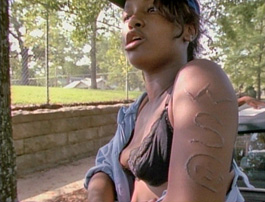 in Little Rock and Back in the Hood are presented full-frame just as they originally aired on HBO. The two documentaries were produced using different formats: Bangin'... was shot primarily on 16mm, and Back in the Hood trades out celluloid in favor of digital video. I'm assuming the transfer for Bangin'... is the same one used for the original broadcasts in 1994, and Back in the Hood has an aliased, prosumer DV appearance, looking more like a network news special than a proper documentary. Neither film looks any better or any worse than I'd expect from an appearance on one of HBO's digital cable channels.
in Little Rock and Back in the Hood are presented full-frame just as they originally aired on HBO. The two documentaries were produced using different formats: Bangin'... was shot primarily on 16mm, and Back in the Hood trades out celluloid in favor of digital video. I'm assuming the transfer for Bangin'... is the same one used for the original broadcasts in 1994, and Back in the Hood has an aliased, prosumer DV appearance, looking more like a network news special than a proper documentary. Neither film looks any better or any worse than I'd expect from an appearance on one of HBO's digital cable channels. Audio: Uneventful Dolby Digital 2.0 tracks accompany both documentaries. I doubt I'd be able to tell much of a difference if I'd played Bangin' in Little Rock through the built-in speakers on my TV instead of pumping it through an overpriced home theater. Back in the Hood boasts a more substantial low-end but the quality of the recording is even spottier, with many of the participants sounding harshly clipped and edgy. Nothing more than serviceable.
The DVDs also include Spanish dubs of each film as well as optional English closed captions. Some of Moran's gang-speak in Back in the Hood is subtitled despite the fact that he's mostly intelligible.
Supplements: This Gang Wars set spreads the extras across each of its two discs. The sole extra on the first disc is a commentary for Bangin' in Little Rock with producer/director Marc Levin, producer Daphne Pinkerson, and former country coroner Steve Nawojczyk. It's not the most energetic discussion -- Pinkerson says next-to-nothing during the hour long commentary, and Nawojczyk and Levin occasionally fall into the trap of watching the film rather than talking about it -- but it does offer a great deal of background information on the project. The three
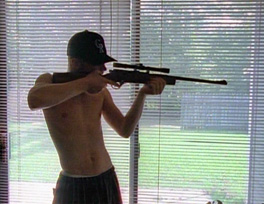 of them discuss the origins of the film, describe how big-city gangs can wind up in a sleepy midwestern city like Little Rock, comment on the fact that the HBO crew wasn't met with the warmest reception during production, and delve in-depth into the events surrounding the drive-by so memorably captured in the documentary. The speakers are also fond of comparing the gang wars in Little Rock to the post-9/11 world, noting that the gang members share a martyr complex with some aggressors overseas and even point out that Army surgeons trained on removing bullets in Little Rock due to the sheer number of gunshot wounds there. It's not an exceptional audio commentary, but viewers with a strong interest in the subject matter should find it worth a listen.
of them discuss the origins of the film, describe how big-city gangs can wind up in a sleepy midwestern city like Little Rock, comment on the fact that the HBO crew wasn't met with the warmest reception during production, and delve in-depth into the events surrounding the drive-by so memorably captured in the documentary. The speakers are also fond of comparing the gang wars in Little Rock to the post-9/11 world, noting that the gang members share a martyr complex with some aggressors overseas and even point out that Army surgeons trained on removing bullets in Little Rock due to the sheer number of gunshot wounds there. It's not an exceptional audio commentary, but viewers with a strong interest in the subject matter should find it worth a listen. Disc two includes a set of "one decade later" interviews that run around sixteen and a half minutes in total. All three of them -- a more mature Taz, the still-imprisoned Kool-Aid, and Misty, speaking for her Aryan Bible-thumping husband KK -- all look back on their teenaged years with regret. Taz has left both Little Rock and that lifestyle behind, although Misty was knocked up at age fifteen and is left with a permanent reminder of those days. Misty's interview is the most painful of the three since KK sounds deranged, as does Kool-Aid as he spends most of his time rambling about race.
In his four minute follow-up interview, coroner Steve Nawojczyk responds to accusations that the drive-by captured in Bangin' in Little Rock was staged and notes that no matter how many police resources are devoted to the gang problem, gangs will exist until the societal problems that create them are eliminated. Finally, Russell Simmons speaks for three and a half minutes on the influence of poverty and race on both the gang lifestyle and hip-hop, briefly referencing Bangin' in Little Rock.
Conclusion: The hour-long documentary Bangin' in Little Rock is such a distinctive, memorable look at the gang lifestyle and mindset that even well over a decade after it first aired on HBO, I still hear references to it fairly often. The follow-up Back in the Hood is far more routine, and neither it nor the discs' extras add enough value for me to recommend spending twenty dollars to buy this set. I'd certainly recommend Gang Wars as a rental, though. Rent It.
Related Links: Steve Nawojczyk, the coroner who left such a stamp on Bangin' in Little Rock, maintains a website and a blog about gang intervention at GangWar.com.
|
| Popular Reviews |
| Sponsored Links |
|
|
| Sponsored Links |
|
|
| Release List | Reviews | Shop | Newsletter | Forum | DVD Giveaways | Blu-Ray | Advertise |
|
Copyright 2024 DVDTalk.com All Rights Reserved. Legal Info, Privacy Policy, Terms of Use,
Manage Preferences,
Your Privacy Choices | |||||||









